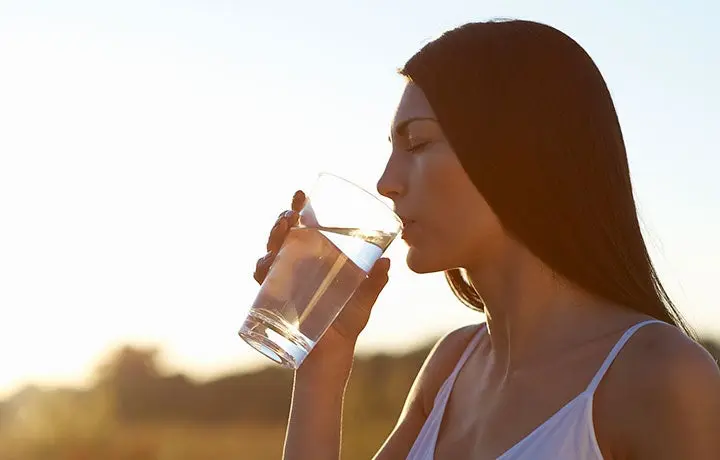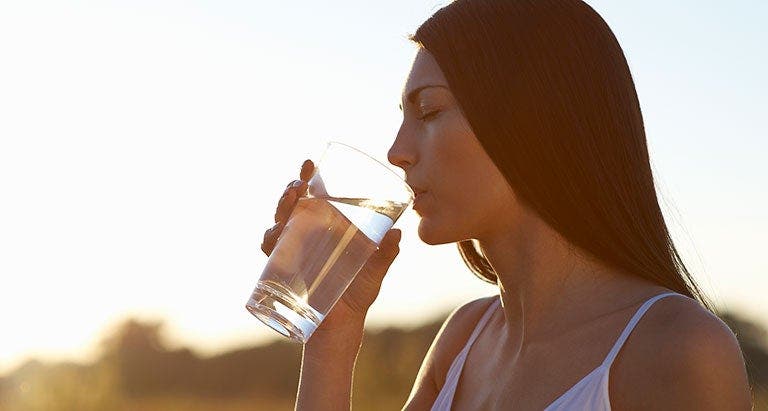The Scoop on Water


Water is pretty much the simplest, healthiest drink you can choose to quench your thirst and hydrate your body. Except when it isn't. There are so many name-brand waters on shelves these days that choosing which water to sip can be trickier than deciding on an espresso beverage at your local fancy coffee shop. Allow us to help by distilling all the information down to the essential news you need.
The Bottled Water Brouhaha
Turns out, bottled water isn’t necessarily better than plain old tap water. In a four-year study, the National Resources Defense Council (NRDC) found that about 25 percent or more of bottled water is really just tap water in a bottle. And about 22 percent of the brands tested had levels of contaminants that exceeded state health limits (bottled water isn’t as tightly regulated as tap water). To find out where a particular brand gets its water, the onus is on the consumer: Call the company and ask directly.
Another thing about bottles: Unless they’re recycled, they create a lot of waste—upwards of 2 million tons wind up in landfills each year. What’s more, manufacturing uses millions of barrels of oil (and, surprisingly, three times the amount of water that goes into the bottle). They also contribute to global warming because they’re often shipped long distances—even if they contain the same stuff you can get from your own faucet.
So what’s the solution? You could carry filtered tap water in a reusable water bottle. (To learn how pristine your tap water really is, call your local water company. A “right-to-know” clause in the drinking water law means your tap water supplier is obliged to give you water-quality reports.) Use a filter certified by NSF (National Sanitation Foundation) International. Also be sure to follow manufacturers’ recommendations about replacing the filter —because without a functional filter, you might as well just drink straight from the tap.
Water with something extra…
Check flavored waters carefully. Some contain added sugar—and calories—while others have calorie-free artificial sweeteners or just the essence of a natural herb like mint. If you’re not a fan of plain old water, flavored varieties can help you get your recommended intake. Another option? Make your own infused waters: Add lemon and lime slices, or sliced cucumber and crushed mint, or mashed berries.
RELATED: 9 Ways to Make Water Tasty
They claim to do everything from clear up your skin to make you skinny. But the truth is that vitamin-enhanced water isn’t a cure-all. There's no such thing as health in a bottle. If you want the small extra boost of vitamins, though, make sure it's not loaded with calories. And none of the vitamin amounts should exceed 100 percent of the Dietary Reference Intake (DRI).
And what about waters touting energy boosts? They're often laden with herbal additives or caffeine, which can disrupt sleep. Fatigue is one sign of dehydration, so regular water might just perk you up on its own.
Bottom line: Drinking fortified waters in moderation because you like the taste is one thing, but don't think about it as a move for health. Your best bet is to eat a balanced diet to get your vitamins from your food.
Water 101
Shopping for just plain water? Here are some of the options you might find at the grocery store.
- Artesian well water comes from layers of rock or sand underground. When the well is tapped, the pressure pushes the water to the surface.
- Mineral water comes from an underground source that contains a specified amount of minerals and trace elements.
- Spring water also comes from underground, but unlike artesian water, it flows naturally to the earth's surface.
- Filtered water can be produced at home with a filter on a water spigot, a carbon-filter pitcher such as Brita, or a refrigerator that dispenses water through a filter.
- Purified water has been treated by distillation, reverse osmosis,or another process approved by the FDA.
- Distilled water is water that has been turned into a vapor — to leave the minerals behind—and then condensed back into water.
